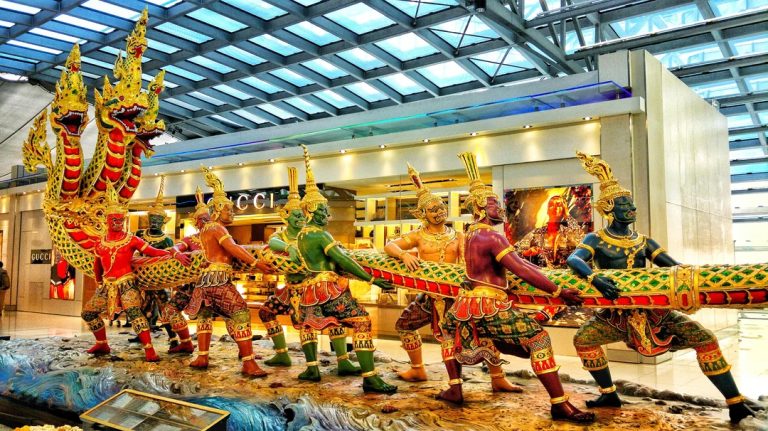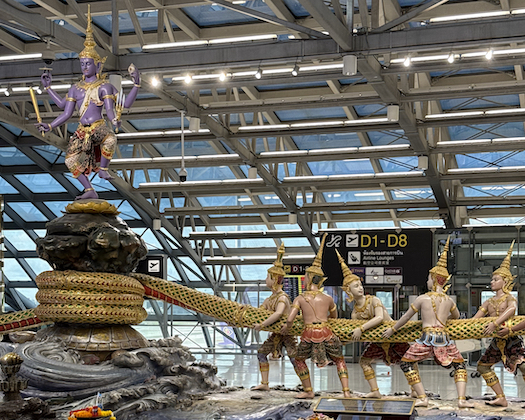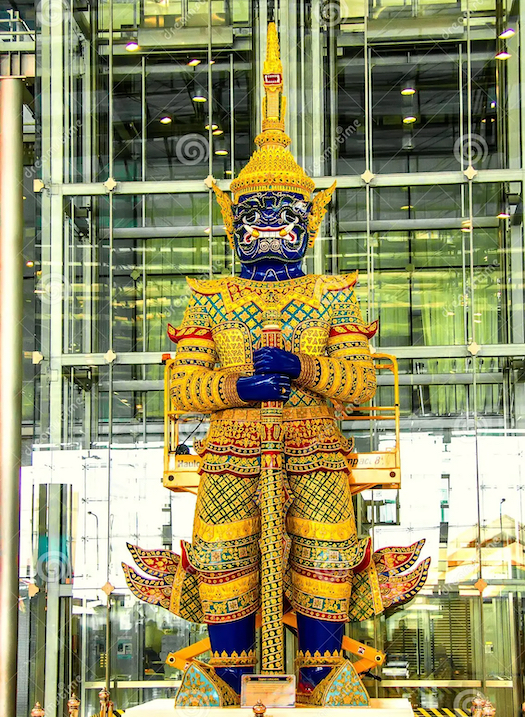
Bangkok’s Suvarnabhumi Airport Showcases Lord Vishnu and Samudra Manthan: A Symbol of Unity, Heritage, and Myth
Bangkok — Travelers passing through Bangkok’s Suvarnabhumi International Airport are greeted by a monumental sculpture depicting the Samudra Manthan, or the Churning of the Ocean of Milk—a pivotal episode from Hindu mythology.

This 21-meter-long installation, located in the airport’s departure hall, is more than an artistic centerpiece; it is a profound cultural symbol bridging Thai heritage and universal mythology.
The Samudra Manthan sculpture was installed to highlight Thailand’s deep cultural and historical ties to Hinduism, which have influenced Thai art, literature, and architecture for centuries.
By featuring this mythological scene, the airport aims to offer travelers a glimpse into the country’s spiritual depth and artistic excellence, while also serving as a welcoming gesture to millions of international visitors each year.
The installation is a testament to Thailand’s commitment to preserving and promoting its cultural heritage in a globalized world.
The sculpture is a contemporary interpretation crafted by skilled Thai artisans, blending traditional Thai and Hindu artistic styles. The continued maintenance and prominence of the statue underscore its enduring significance as a cultural landmark within the airport since 2008.
The Samudra Manthan scene originates from ancient Hindu scriptures, including the Bhagavata Purana, Mahabharata, and Vishnu Purana. The story narrates how the gods (Devas) and demons (Asuras) collaborated to churn the cosmic ocean (Kshira Sagara) to obtain Amrita, the nectar of immortality.
Mount Mandara served as the churning rod, and Vasuki, the serpent king, was used as the rope. Lord Vishnu, central to the narrative, is depicted overseeing the process, sometimes incarnating as a tortoise (Kurma avatar) to support the mountain during the churning.
The process yielded divine treasures, including the goddess Lakshmi and the physician Dhanvantari, who emerged with the pot of Amrita. Ultimately, Vishnu intervened to ensure the nectar was distributed among the gods, maintaining cosmic balance.
Significance and Importance

Cultural and Spiritual Symbolism:
The sculpture is not just a depiction of a myth; it embodies themes of unity, cooperation, and cosmic harmony. The collaboration between Devas and Asuras reflects the value of teamwork, an enduring principle in Thai society. The balance between opposing forces resonates with Buddhist teachings on equilibrium and the Middle Way, further integrating the myth into Thailand’s cultural fabric.
Gateway to Thai Heritage:
As one of the world’s busiest airports, Suvarnabhumi serves as a gateway to Thailand. The statue greets travelers with a powerful narrative of creation, perseverance, and the rewards of cooperation. It also positions Thailand as a cultural bridge between East and West, highlighting shared human values and the interconnectedness of global traditions.
Artistic Excellence:
The statue’s intricate craftsmanship and vibrant colors capture the dynamism and spiritual essence of the myth. Central figures such as Lord Vishnu, the Devas, Asuras, Mount Mandara, and celestial maidens are depicted with meticulous detail, creating an immersive experience for visitors.
A Universal Message:
Beyond its cultural specificity, the Samudra Manthan sculpture at Suvarnabhumi Airport stands as a universal symbol of the eternal struggle between good and evil, the necessity of cooperation, and the enduring relevance of ancient wisdom in modern society.
At Bangkok Airport: Lord Vishnu & Samudra Manthan Sculpture (April 20, 2025)